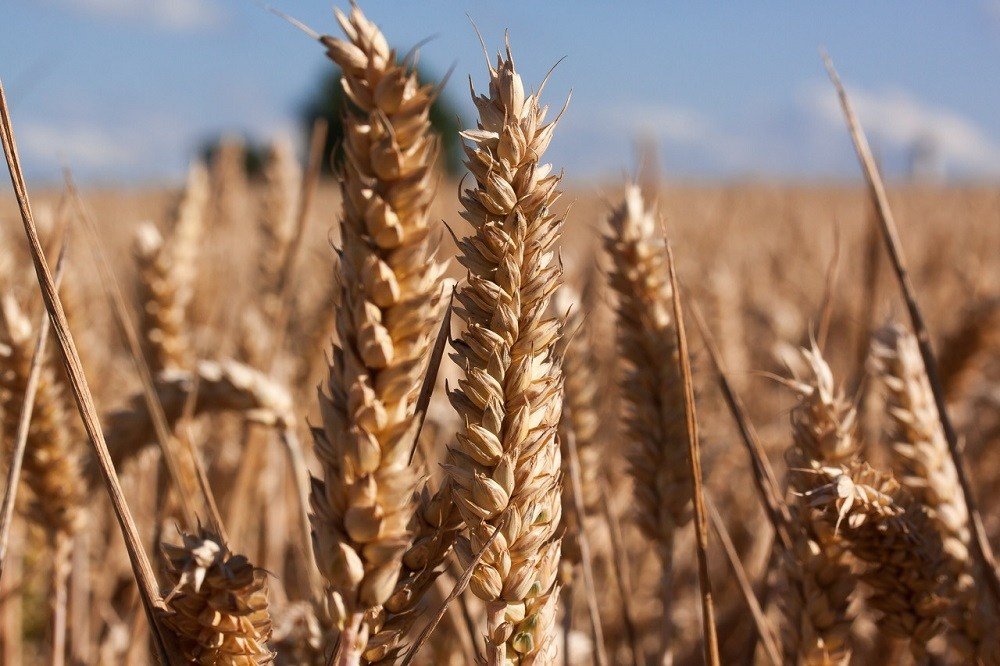Business
Why wheat planting in Canada has been delayed
US wheat prices will probably move to the higher end of the world price range.

It is dry in the Dakotas and the southern Prairies, while the northern Prairies have seen too much rain. Planting has been delayed in Canada as well.
Wheat
US markets were higher last week, although the Chicago Winter Wheat markets showed some weakness on Friday in response to the USDA production and supply and demand reports. USDA showed an increase in production for Hard Red Winter Wheat against expectations for another production cut. Soft Red Winter production and White Winter production were about as expected. The Spring Wheat estimate was left unchanged until next month when USDA will have much more information about the crop. World data showed solid increases in ending stocks estimates for both this year and next year and was considered a bearish part of the report. The harvest is underway in Texas and Oklahoma, and reports are mixed. Results indicate that the protein levels are not strong in these areas. Yields are lower as well. The Kansas crop started its harvest late last week. Yield reports were low on the initial harvest data, but protein levels were considered satisfactory. The need for higher protein Wheat has helped support Minneapolis Spring Wheat futures in the past week.
Minneapolis has also been supported by bad growing conditions in Spring Wheat areas of the northern Great Plains and the Canadian Prairies. It is dry in the Dakotas and the southern Prairies, while the northern Prairies have seen too much rain. Planting has been delayed in Canada and the crop condition ratings in the US are lower than expected by the trade. These conditions and ratings are creating concern about the potential for a smaller crop even as demand expectations increase due to the lower Winter Wheat quality and yields. The Midwest has seen plenty of rain, so a lower quality crop is expected, although yields, in general, could be strong. Lower supply expectations will help support Winter Wheat futures but the lower quality will hurt the overall demand profile. The export market will remain difficult as there is still a lot of Wheat around. Russia is cutting back production expectations a bit and there are questions about Ukraine and Europe Wheat production, but Australia has a very good crop and Argentina is talking about a very good crop as well. US prices will probably move to the higher end of the world price range after the harvest is complete later this Summer. The weekly charts show the potential for Winter Wheat prices to move higher over time.

Weekly Chicago Soft Red Winter Wheat Futures © Jack Scoville

Weekly Chicago Hard Red Winter Wheat Futures © Jack Scoville

Weekly Minneapolis Hard Red Spring Wheat Futures © Jack Scoville
Corn
Corn and Oats were higher last week. USDA made no changes to the supply and demand data for Corn this or next year and appears willing to wait for the quarterly stocks report and the planted área report at the end of the month before making any alterations in its projections. The world projections showed an increase in ending stocks for this year, but a decrease for next year. The projections were mostly as expected, and the market returned to trading weather forecasts and growing conditions in the Corn Belt. Trends are up on the daily and weekly charts for Corn, and the weekly charts imply that rallies to 403 and 430 bases the nearby contract are possible. The Corn Belt saw some very hot temperatures over the weekend and more heat is in the forecast for this week. Crops in some areas are showing signs of stress. There are already reports of leaves rolling in Illinois as the roots have not developed enough to tap into subsoil moisture. Crop progress remains generally good, as planting is now about done and emergence is reported everywhere. Ideas are already that the top edge of yield potential is gone, although the potential for very good production is still very much there. But, the weather must stay good. The trade is concerned about the potential for more hot and dry weather later this Summer due to the much above normal temperatures seen this early in the season, and these fears will help keep buying interest in the market for a while or until July when reproduction will be done.

Weekly Corn Futures © Jack Scoville

Weekly Oats Futures © Jack Scoville
Soybeans and soybean meal:
Soybeans and products were higher and closed the week on a strong note. The close was good in light of the USDA reports released on Friday. USDA cut domestic demand as expected by the trade, but left export demand unchanged despite the fact that US export sales are now ahead of projections. The production side was left unchanged for this year and next year, and demand ideas for next year were unchanged. This was as expected. The moves created an increase in ending stocks projections for this year and next year against expectations for mostly unchanged data. World data showed increased production from Brazil that was as expected. World ending stocks were above trade expectations for both the current year and next year. Most soybeans are in the ground now, and most that is left to be planted are double crop beans. Speculators appear to be the best sellers right now as they add to short positions. It was hot and dry in the Midwest over the weekend and more heat is expected this week. Overall the trade remains bearish on the price potential for the entire complex, but is keeping a close eye on the US Dollar that acts weak and the Midwest weather that might stay hot and dry.

Weekly Chicago Soybeans Futures © Jack Scoville

Weekly Chicago Soybean Meal Futures © Jack Scoville
Rice:
Rice closed higher on follow through buying from the big rally of the previous couple of weeks. The potential for big production problems in US Rice growing areas continues to support the move higher. USDA increased its export demand projections for the US in both the current and the next marketing year and gave a fundamental reason for the recent rally. It kept domestic demand projections unchanged and also made no changes for the current production season. No production changes were expected as USDA will have much more data next month and some changes are likely then. World data showed a month to month increase in new crop ending stocks projections as major exporters are expected to have more on hand. The report was considered positive for prices. The weather in most growing areas has improved as it remains warmer and drier. The emergence remains slightly behind the average pace. The crop condition improved on a week to week basis, but remains slightly behind the conditions of last year. The weekly charts show that the rally could move higher over time, with final targets near 1275 basis the nearest futures contract possible.

Weekly Chicago Rice Futures © Jack Scoville
Palm oil and vegetable oils:
World vegetable oils markets were lower last week and price trends are down on the weekly charts. The weekly charts for the various vegetable oils markets remain the weakest of all agricultural futures markets. Palm Oil will get some data from MPOB this week that is expected to be negative to prices. Palm Oil production should be improved by 5.5%, and export data should also move higher. However, the increased export demand is not expected to keep ending stocks from rising due to the seasonal increase in production. Trends remain down on the weekly charts. Both of the private surveyors estimated Malaysian Palm Oil exports above 1.3 million tons for May, and June is off to a strong start as well. A lot of the demand is thought to be related to buying ahead of Ramadan, so the export pace could fade as this festival comes to an end this week. Reports from the interiors of both Indonesia and Malaysia suggest that trees have seen plenty of rain and production should be seasonally increasing. Canola remains relatively strong amid tight Canadian market conditions, but trends are now down. Planting is now about done and the crops are emerging and growing. Western areas of the Prairies are now too dry and this area needs to be watched for potential production losses. Demand from both the processor side and the export side has been strong enough to generally support the market.

Weekly Malaysian Palm Oil Futures © Jack Scoville

Weekly Chicago Soybean Oil Futures © Jack Scoville

Weekly Canola Futures © Jack Scoville
Cotton:
Cotton was lower in reaction to the USDA reports. The reports showed unchanged ending stocks estimated when compared to last month for the current marketing year. This was about as expected. Export demand for the next marketing year was cut and ending stocks were increased, and this was a bearish signal for the trade. Production ideas were unchanged for both years and this was as expected. Warmer and drier weather is expected this week in most production areas, and growing conditions should be good. The charts show that July trends are down and that December is also in a down trend. These trends are likely to remain down in the longer term as the US and maybe the world will produce much bigger crops this year. Monsoon rains are appearing in India and Pakistan and ideas of bigger production in that part of the world. On the other hand, China has been too dry. Central Asia has been dry, but conditions are rated as good.

Weekly US Cotton Futures © Jack Scoville
Frozen concentrated orange juice and citrus:
FCOJ closed higher last week and could be trying to find a short term bottom. USDA increased Florida Oranges production from 68 million boxes to 68.5 million in its reports on Friday. The Florida weather has shown some improvement as rains have moved into the state. These rains were very beneficial as the state had been in a drought. There are no systems in the Atlantic to cause concern about tropical storm development that could be detrimental to trees and fruit. The NOAA Outlook calls for an above normal season, with more storms and more named storms in the general trend. Trends remain mostly down on the charts, and so far there has been very little buying interest. The demand side remains weak and there are plenty of supplies in the US. Brazil has been exporting FCOJ to the US to cover the short Florida crop. Domestic production remains very low due to the greening disease and drought. Trees now are showing fruit of varying sizes and overall conditions are called good because of the irrigation. The Valencia harvest is moving to processors and into the fresh market and is almost over. Brazil crops remain in mostly good condition.

Weekly FCOJ Futures © Jack Scoville
Coffee:
Futures were a little higher last week, but overall price action is not strong. The changes in the relationship between the Real and the US Dollar dictated almost all of the price action. Mostly it was the US Dollar moving lower that helped provide some support. However, temperatures did turn colder in Brazil last weekend, although not cold enough to damage crops. The market action remains weaker overall due to ideas of good supplies and reports of weak demand. The cash market remains very slow with almost no interest seen from roasters. Offers remain in the cash market, and differentials are stable. New York has featured some buying support from speculators as they have become more two sided in trading the market as the Winter season is approaching in Brazil. However, speculators and commercials are still mostly bearish. London had been more stable as overall market supplies remain relatively tight. Offers are less and seen at high prices from Robusta countries such as Vietnam. Indonesia and Brazil are also very low on supplies. The Robusta market is still relatively strong compared to Arabica and due to the short supplies available to the market as it works to curb demand through the higher prices.

Weekly New York Arabica Coffee Futures © Jack Scoville

Weekly London Robusta Coffee Futures © Jack Scoville
Sugar:
It was higher week in New York and London, and charts show that overall trends remain down. It is the threat of increased supplies to the market that has pressured prices in the last few weeks. Production conditions have been better this year in Brazil, and a better harvest is anticipated in the next couple of months despite the weak start as demonstrated in the initial UNICA data a couple of weeks ago. Ideas are that Unica will show an increased crush pace in its data this week as arrivals of cane to mills should have increased. Production in India and Thailand is expected to improve in the coming year. The Indian weather service estimates that the monsoon will be within the normal range. Monsoon rains are now moving into the country. Thailand also hopes for an improved monsoon season this year. China is still importing significantly less Sugar so far this year. The weather in Latin American countries away from Brazil appears to be mostly good. Northeast Brazil remains too dry, but has seen some light precipitation lately. Center South areas have had plenty of rain. Most of Southeast Asia has had good rains. The ISO increased its Sugar surplus estimate for the coming year to 3.0 million tons after a deficit production estimate for the current year.

Weekly New York World Raw Sugar Futures © Jack Scoville

Weekly London White Sugar Futures © Jack Scoville
Cocoa:
Futures markets were a little higher last week. Both markets are now testing back into the low area that the markets left just a few weeks ago. The overall market situation remains generally bearish, although fundamentals could change in the longer term. Harvest activities in West Africa are completed. The demand from Europe is reported weak overall, and the North American demand has been weaker. The next production cycle still appears to be big on the growing conditions around the world are generally very good. West Africa has seen much better rains this year and now getting warm and dry weather. Growing conditions are good. East African conditions are now called good. Good conditions are still being reported in Southeast Asia. The ICCO last week estimated West African production at 1.78 million tons. It said production would be 382,000 tons above demand, an increase from previous estimates.

Weekly New York Cocoa Futures © Jack Scoville

Weekly London Cocoa Futures © Jack Scoville
Dairy and meat:
Dairy markets were lower last week, but longer term trends remain up. It looks like dairy prices are now in a correction mode. Supplies are strong seasonally in all areas of the US. Demand is good for cream, and cheese makers are displaying increasing demand. Cream demand for Butter has been very good as orders for print butter have increased. However, butter inventories in cold storage are increasing in some areas. Demand for Ice Cream has been mixed depending on the region. Cheese demand appears to be getting stronger due to promotions on the retail level. Exports are reported to be stronger. Dried products prices are generally weaker. World prices have been firming in the last month on reduced Oceana production and steady to firm demand prospects, mostly from Asia.
US cattle and beef prices were higher. The beef market has been strong, and packers paid higher prices for cattle last week. Feedlots are very current with supplies and are pulling cattle ahead in order to take advantage of the high prices. The trade is worried about a trend change to down given that the market has been very strong, but the cash market keeps holding and demand is also holding. April went off the Board on Friday and now June is too cheap when compared to cash prices. That implies that the market will need to rally again this week or that cash will continue to fall.
Pork markets and Lean Hogs futures were firm on ideas that cash market values had bottomed recently. Cash markets have had a firm tone inside the US despite strong hog availability. Pork demand remains stronger than expected, but packers have been pulling back from the market as they sense increasing supplies are coming. Packer demand has been very good until now. There are big supplies out there for any demand. The charts show that the market could work lower.

Weekly Chicago Class 3 Milk Futures © Jack Scoville

Weekly Chicago Cheese Futures © Jack Scoville

Weekly Chicago Butter Futures © Jack Scoville

Weekly Chicago Live Cattle Futures © Jack Scoville

Weekly Feeder Cattle Futures © Jack Scoville

Weekly Chicago Lean Hog Futures © Jack Scoville
—
DISCLAIMER: This article expresses my own ideas and opinions. Any information I have shared are from sources that I believe to be reliable and accurate. I did not receive any financial compensation in writing this post, nor do I own any shares in any company I’ve mentioned. I encourage any reader to do their own diligent research first before making any investment decisions.

-

 Crypto5 days ago
Crypto5 days agoBitMine Surpasses 4 Million ETH Holdings Amid Market Volatility
-

 Crypto2 weeks ago
Crypto2 weeks agoTether Targets $500 Billion Valuation in Landmark Funding Push
-

 Markets1 week ago
Markets1 week agoDow Jones Strength Faces Risk From a Potential Yen Carry Trade Unwind
-

 Business2 weeks ago
Business2 weeks agoPrecious Metals’ Bull Market Continues


























You must be logged in to post a comment Login